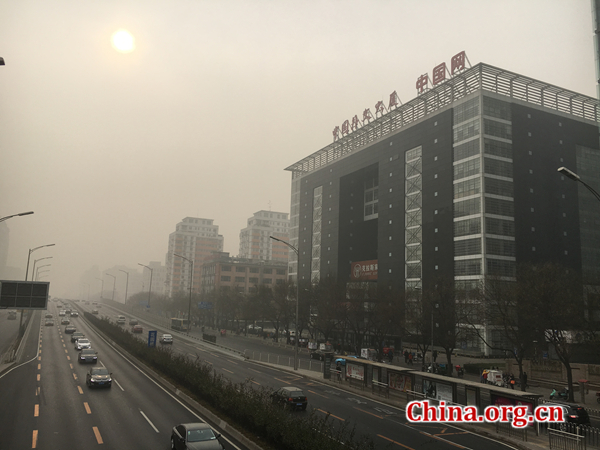Amid mass anxiety over smog, few ready to make individual sacrifices for common good
- By Wan Lixin
 0 Comment(s)
0 Comment(s) Print
Print E-mail Shanghai Daily, January 3, 2017
E-mail Shanghai Daily, January 3, 2017
|
|
|
Photo taken on the noon of Dec. 20, 2016 shows the Third Ring Road shrouded in smog in Beijing, capital of China. [By Li Huiru / China.org.cn] |
A friend in Beijing said the smog was so bad, that his primary school son had to study on his own at home for three days. I guessed at least the son might like the smog if it meant staying home, but he answered that it's more fun going to school. The friend said pictures and articles about the poor air in Beijing made him embarrassed to mention where he lives.
There's no need for embarrassment now though. A strong wind scattered the pall, sending some of it southward. When I browsed the headlines on major Internet portals on Monday, sure enough, smoggy stuff had been completely sanitized. Now we can broach something more suitable for the year-end: growth, employment and prosperity.
One of our troubles in tackling the air pollution stems from our inability to see and act consistently.
Making the rounds on WeChat last week was a picture of a front-page newspaper, from 17 years ago, featuring officials vowing to fight against smog, with the headline "By No Means Allow Smog to Go into the New Century!"
At the heart of this airy promise is our failure to confront the true social and environmental costs of the heady growth we have become accustomed to talking about so glowingly.
This handicap compels us to deal in doubletalk, subterfuge and evasion.
We've all become perceived victims, finger pointing, accusing, blaming others — even private car drivers.
One driver in Beijing groused that he drives a standard car on standard fuel, but is blamed for creating the smog. "Can it be the way I step on the throttle?" He mused, feigning innocence.
The epic smog and red-alert led to restricted car use in Beijing based on odd-even license plate number. It was inconvenient, even though smog is now a leading cause of pulmonary disease and other serious conditions.
But with the red alert gone, cars will hit the roads again, and factories can work overtime to make up for lost output.
We have to pay for the good life, and we are willing to continue to pay for better life. If energy consumption is a gauge of good life, then take heart: per capita energy consumption in China is still less than 30 percent of that in the United States, leaving plenty of room to grow.
We cannot afford to allow this trifle to distract us from more compelling preoccupations, can we? In the year 2015, Beijing had 179 days when the air quality was substandard.
This outlook precludes the possibility of decoupling from practices that contributes to pollution: Industrial production, increased motor vehicles use and coal reliance.
Starting this week, a dip in manufacturing output is more a cause for worry than celebration. A car remains a salient feature of prosperity and middle-class respectability. And coal prices are going up, to the consolation of many.
In tackling our air troubles, we assume an attitude of toleration, unlike our attitudes towards food, where trace amounts of poison will scare us.
We allow the poison in the air to build up to a certain level, and will only cry foul after it becomes hazardously poisonous. This makes us unprepared for the painful transition to blue skies. We are more likely to flirt with seeming solutions. Energy-saving technology is good, but it has to be measured against the scale of industrial activity. If the pollution resulting from growth in scale outpaces savings in clean technology, we will see steady growth in aggregate emissions, and growing intensity in pollution.
Unfortunately, many pretend not to see this. Thus we talk glibly about PM2.5, debate endlessly about the efficacy of gauze masks, become horrified at London's Great Smog of 1952 which killed between 4,000 to 12,000 people — but we grow mutinous at the mere suggestion of having to stop driving a car, for one day.
We continue to respond enthusiastically to artificially staged shopping extravaganzas, even though our abstinence from unnecessary consumption could easily stifle smog-belching chimneys. It is fairer to suffer collectively than sacrifice individually, even when it comes to things we'd be better off without.
Could the recent smog catalyze change? The answer lies with you and me, in our individual actions, and with the government, which can play a bigger role by giving incentives to those who choose to live responsibly, and penalizing the wasteful.






